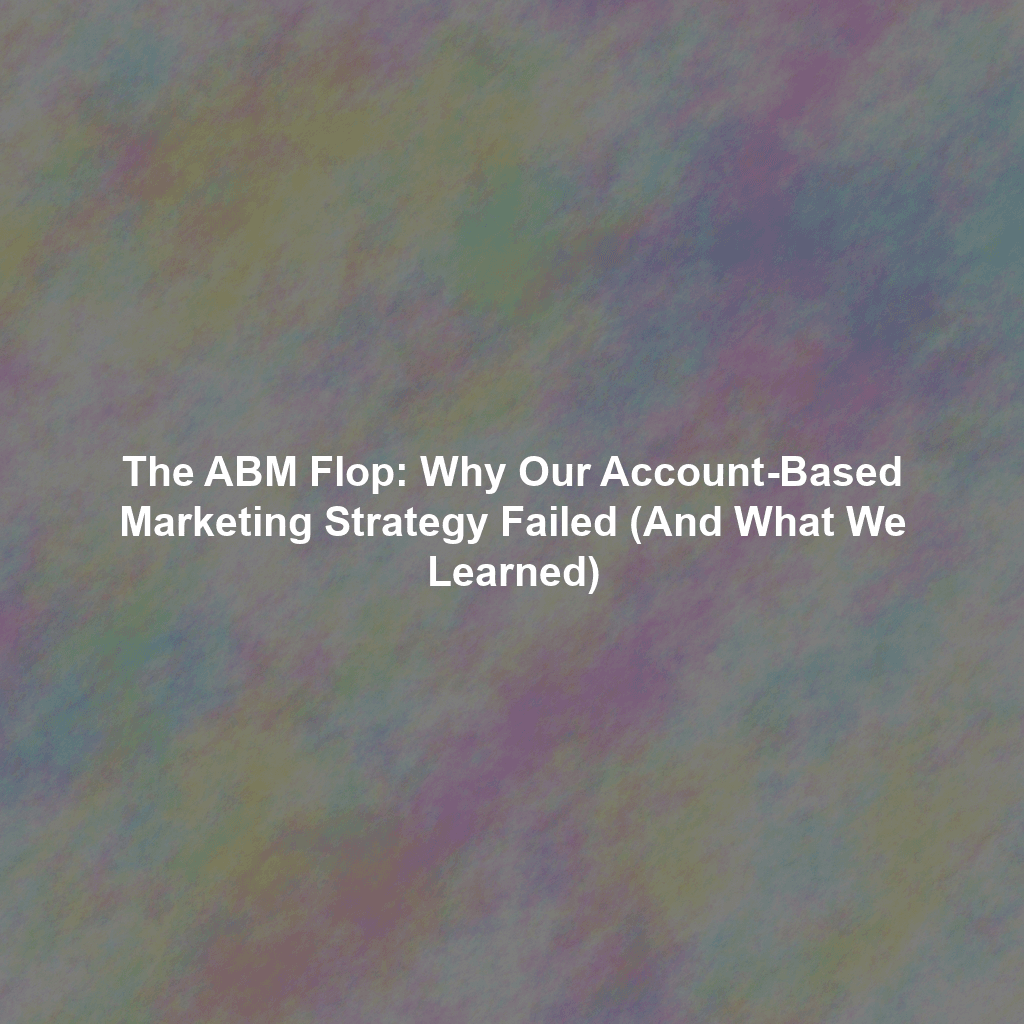Account-Based Marketing (ABM) – it’s often heralded as the promised land of B2B lead generation. The allure is undeniable: hyper-targeted messaging, laser-focused resource allocation, and the seemingly guaranteed promise of a significant, predictable ROI. That’s precisely the vision we held when our team enthusiastically embarked on our ABM journey just six short months ago. We envisioned closing massive, transformative deals with key strategic accounts, fundamentally reshaping and accelerating our sales pipeline, and finally silencing the internal critics who doubted marketing’s direct ability to impact tangible revenue figures. The reality, however, was a stark and humbling contrast. What actually transpired was a considerable amount of wasted time, significant budget overruns, and ultimately, a campaign that fizzled out with a whimper, not a bang. This is the candid story of our ABM flop, a painful but unequivocally valuable lesson in what *not* to do when venturing into this complex marketing methodology.
STRATEGIC WARNING:
ABM is not a silver bullet. Without rigorous planning, deep insights, and true sales-marketing alignment, it can quickly become a costly exercise in futility.
The Allure of Account-Based Marketing: Why We Fell for the Promise
Before delving into the specifics of our ABM disaster, it’s crucial to understand the compelling rationale that initially drew us to this approach. Our traditional, volume-based lead generation efforts were yielding increasingly diminishing returns. We were generating a large volume of raw leads, certainly, but the quality was alarmingly inconsistent. Our highly skilled sales team was spending an inordinate amount of time and energy chasing prospects who were, frankly, not a good fit for our solution – either lacking budget, immediate need, or strategic alignment. This inefficiency was a drain on resources and morale.
ABM, with its strategic focus on a select group of high-value, pre-qualified accounts, appeared to be the perfect antidote. The promise was clear: by concentrating our marketing and sales efforts on a finite number of “whale” accounts, we could drastically improve lead quality, accelerate sales cycles, and significantly boost overall sales efficiency. It felt like a sophisticated, precision-guided missile compared to our previous scattershot approach. The theoretical ROI was simply too compelling to ignore, and we were eager to prove its worth.
Where We Went Wrong: A Three-Pronged Failure in Execution
Looking back with the unforgiving clarity of hindsight, our ABM failure wasn’t attributable to one singular, isolated mistake. Rather, it was the cumulative effect of a combination of critical missteps across three fundamental areas of ABM execution. Each flaw compounded the others, leading us down a path of inefficiency and disappointment.
Flawed Target Account Selection: The Foundation of Failure
This was arguably our most significant blunder, the crack in the very foundation of our ABM strategy. We approached target account selection with a superficial, almost “spray and pray” mentality, albeit with a slightly smaller spray. Our primary criteria for identifying companies were basic firmographic data: size (revenue, employee count) and industry. We compiled a list of 50 “dream accounts” based almost exclusively on publicly available data. What we critically failed to do was conduct thorough, in-depth research into their specific, nuanced challenges, their immediate strategic needs, or their existing technology stacks and vendor relationships. We operated under the dangerous assumption that simply because they were large companies within our target industry, they were automatically a good fit for our complex solution. This assumption proved to be utterly disastrous.
Many of these “dream accounts” were already locked into long-term, iron-clad contracts with direct competitors, weren’t actively facing the specific problems our solution was designed to solve, or simply lacked the budget, internal bandwidth, or political will for a new, significant initiative. We were knocking on doors that were firmly bolted shut, wasting precious resources and time. The sales team quickly grew frustrated by the lack of genuine receptiveness, and our marketing efforts felt like shouting into a void.
LESSON LEARNED: Account Selection is Paramount.
Thoroughly vet potential target accounts. Go far beyond surface-level data. Engage with industry analysts, leverage intent data, connect with people inside the organizations (ethically!), and deeply understand their specific pain points, strategic priorities, and political landscape. Quality over quantity is not just a mantra; it’s the bedrock of ABM success.
Impersonal Personalization (The Oxymoron): A Missed Connection
We understood, intellectually, the paramount importance of personalization in ABM. However, our execution of this critical element was, to put it mildly, severely lacking. We created generic case studies with their company logos crudely “slapped on,” sent out mass emails with personalized subject lines (that were often poorly executed and felt, well, frankly, a bit creepy), and ran broad retargeting ads that merely featured their company name. We proudly labeled this “personalization,” but in reality, it was superficial, lacked genuine insight, and utterly failed to resonate with our target accounts. We fundamentally failed to grasp that true personalization demands a deep, nuanced understanding of each account’s unique needs, challenges, and aspirations.
Consider this painful example: we diligently sent a seemingly relevant case study to the Head of Sales at “Company X,” highlighting how our solution had purportedly helped a similar organization increase its sales by a remarkable 20%. What we tragically didn’t know, due to our superficial research, was that Company X was at that very moment undergoing a massive, painful organizational restructuring, and their primary strategic focus was on drastic cost reduction and operational efficiency, not revenue growth. Our carefully crafted messaging was completely off-target, irrelevant, and likely perceived as tone-deaf. It was a wasted impression, a missed opportunity, and a testament to our shallow approach.
LESSON LEARNED: Personalization Must Be Authentic.
Personalization should be genuine, insightful, and based on real, deep understanding. Don’t just add a name and logo; that’s basic mail merge, not ABM. Invest significant time in understanding each account’s specific pain points, strategic challenges, internal politics, and overarching goals. Tailor your messaging, content, and value proposition to directly address those unique needs, demonstrating empathy and genuine problem-solving.
Measurement Without Meaning: The Vanity Metric Trap
Perhaps the most insidious aspect of our ABM failure was our misguided approach to measurement. We diligently tracked all the easily accessible “vanity metrics”: website visits from target accounts, email open rates, ad impressions, and content downloads. We generated impressive-looking dashboards filled with activity data. But we critically failed to connect these metrics to actual, tangible business outcomes. We became so fixated on activity – the inputs – that we completely lost sight of the ultimate goal: generating genuinely qualified leads that progressed through the pipeline and, most importantly, closing deals that directly impacted revenue.
We neglected to establish clear, measurable Key Performance Indicators (KPIs) upfront that were directly aligned with sales objectives. We lacked a robust system for tracking the true impact of our ABM efforts on the sales pipeline velocity, deal size, or win rates. At the conclusion of the campaign, we had a plethora of impressive-looking numbers on our reports, but no concrete, defensible evidence that our ABM efforts had actually contributed to revenue generation. The marketing team couldn’t prove its value, and the sales team remained unconvinced.
LESSON LEARNED: Focus on Outcomes, Not Just Activity.
Define clear, measurable KPIs that are directly aligned with sales and business objectives *before* launching your ABM campaign. Track the *entire* customer journey, from initial engagement to closed deal. Focus on metrics that truly matter, such as lead conversion rates, pipeline velocity, deal size, and ultimately, revenue contribution. Invest in sophisticated analytics tools that provide deep, actionable insights into the effectiveness and ROI of your ABM efforts.
The Silver Lining: Key Takeaways and a Clear Path Forward
Despite the undeniable failure, our ABM experiment was far from a complete waste of time or resources. It was, in fact, a painful but invaluable learning experience. We extracted critical, hard-won lessons that are now fundamentally informing and reshaping our future marketing strategies. This crucible of failure has provided us with a clearer, more realistic roadmap for success. Here are some key takeaways that we’ve internalized:
- Deep Account Dive is Essential: Never again will we rely on superficial data. We now invest significant time and dedicated resources in meticulously researching and truly understanding our target accounts at a granular level. This includes their organizational structure, strategic initiatives, competitive landscape, and individual stakeholder pain points.
- Personalization Beyond the Basics: We’ve moved past mere name-and-logo personalization. Our focus is now on creating genuinely personalized content and messaging that directly addresses the specific, unique needs, challenges, and aspirations of each individual account and its key stakeholders. This requires bespoke content and tailored value propositions.
- Data-Driven Decisions, Metrics That Matter: We have fundamentally overhauled our measurement framework. We now establish crystal-clear, measurable KPIs directly aligned with sales and revenue objectives *before* any campaign launch. We rigorously track the entire customer journey and invest in analytics that provide actionable insights into the true impact of our ABM efforts on the sales pipeline and closed-won revenue.
- Sales and Marketing Alignment: ABM is a Team Sport: We’ve recognized that ABM cannot succeed in silos. We are fostering significantly stronger, more fluid communication and true collaboration between our sales and marketing teams. This ensures shared understanding of target accounts, aligned messaging, and a unified approach to account engagement.
- Start Small, Scale Smart: Iterative and Agile: Our future approach will be more iterative. We will begin with well-defined pilot programs targeting a smaller, highly qualified group of accounts. This allows for rapid learning, optimization, and validation of our strategies before committing to a larger scale ABM rollout.
We are now approaching ABM with a renewed perspective – one grounded in realism, data, and continuous learning. We’re focusing on a smaller number of highly targeted accounts, investing significantly more in deeper research and authentic personalization, and implementing a far more robust, outcome-oriented measurement framework. Crucially, we’re fostering closer, more integrated collaboration between our sales and marketing teams to ensure that our ABM efforts are not just aligned with, but directly contributing to, their ambitious sales goals.
Conclusion: From Flop to Future Success – The Power of Learning
Our initial ABM flop was, without a doubt, a humbling and costly experience. Yet, it proved to be an invaluable crucible, providing profound lessons that will fundamentally help us build a significantly more effective and genuinely successful ABM strategy in the future. By courageously confronting and learning from our mistakes, by embracing a more rigorous, data-driven, and truly collaborative approach, we are now supremely confident that we can unlock the true, transformative potential of Account-Based Marketing and achieve our ambitious business goals.
Hopefully, our candid story serves as both a cautionary tale – highlighting the pitfalls of superficial execution – and a helpful guide for others venturing into the complex, rewarding world of ABM. Remember, true success in Account-Based Marketing is not about blindly following a checklist; it’s about deeply understanding your target accounts, consistently delivering real, tailored value, fostering seamless sales-marketing alignment, and relentlessly optimizing your efforts based on measurable outcomes. The journey to ABM mastery is iterative, but the rewards for those who learn and adapt are substantial.
 Skip to content
Skip to content

